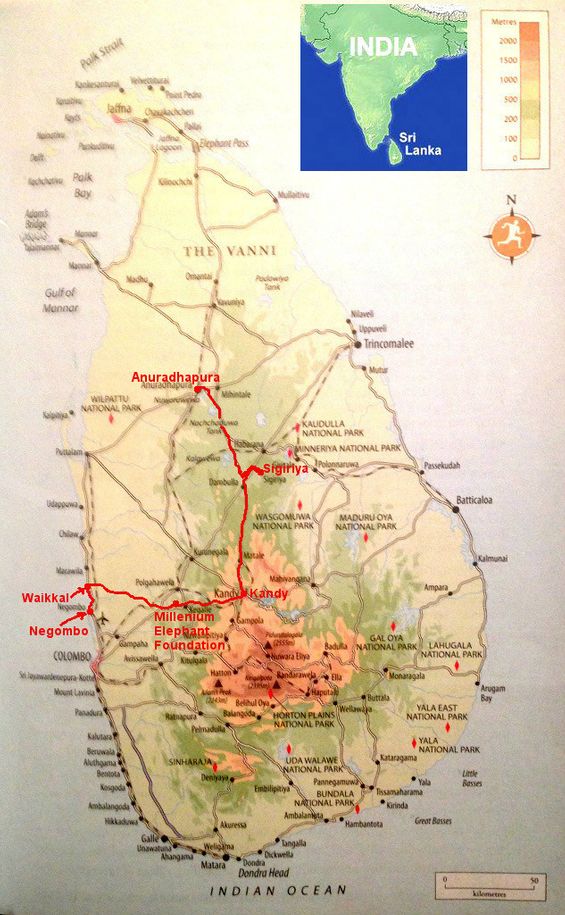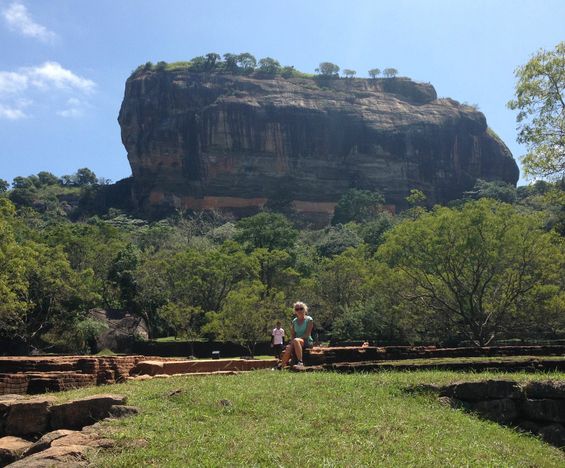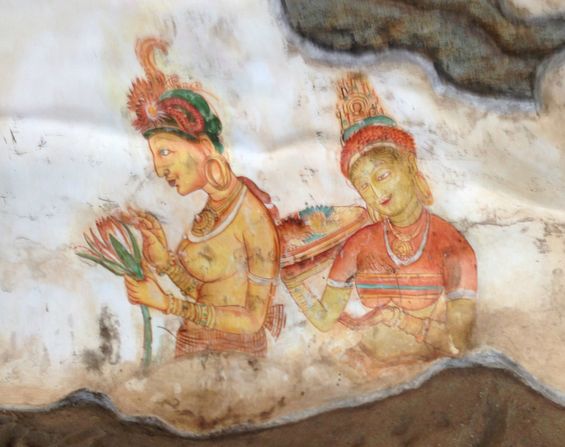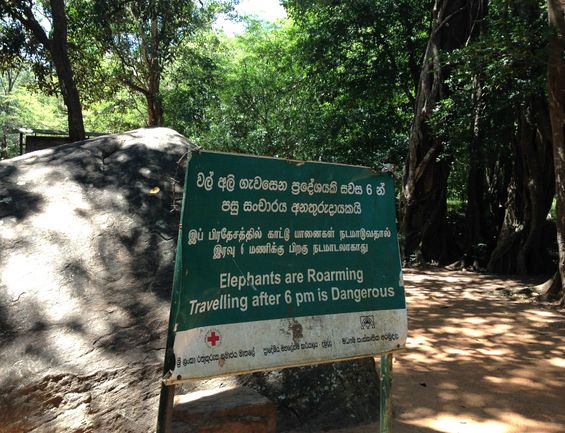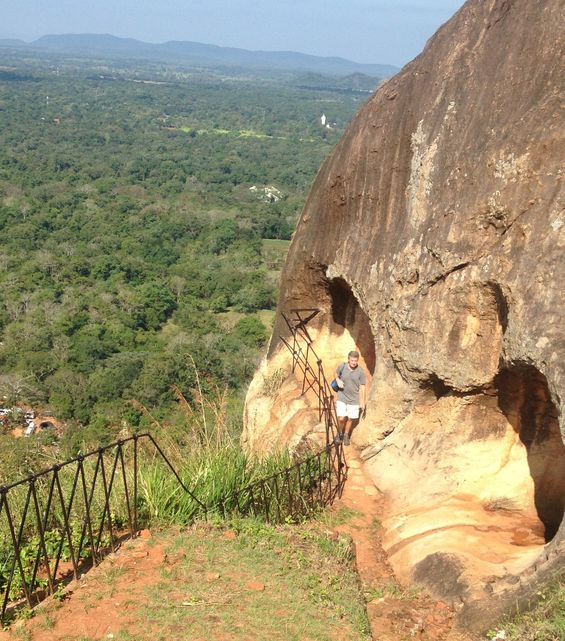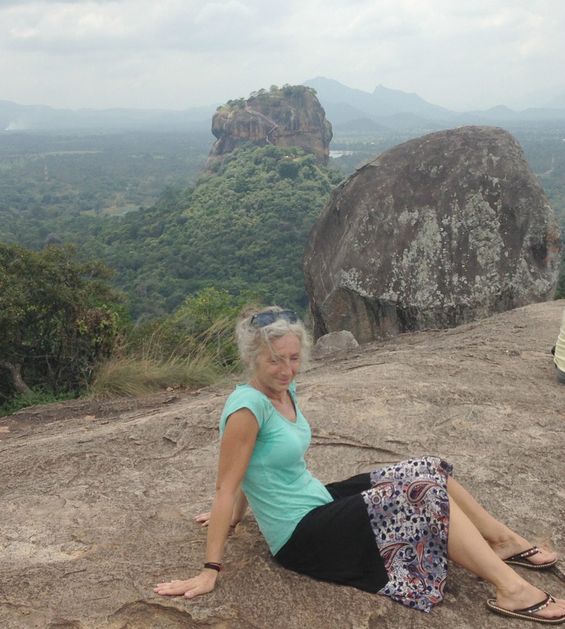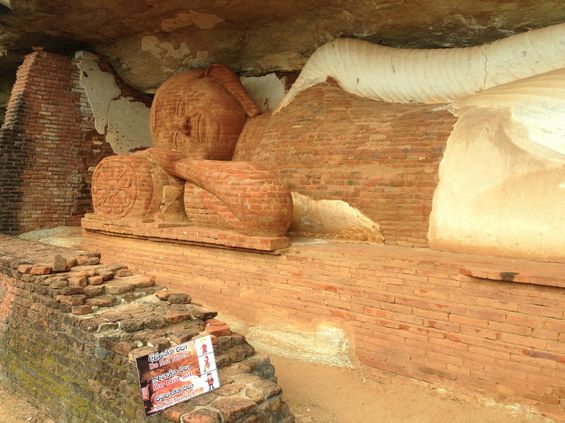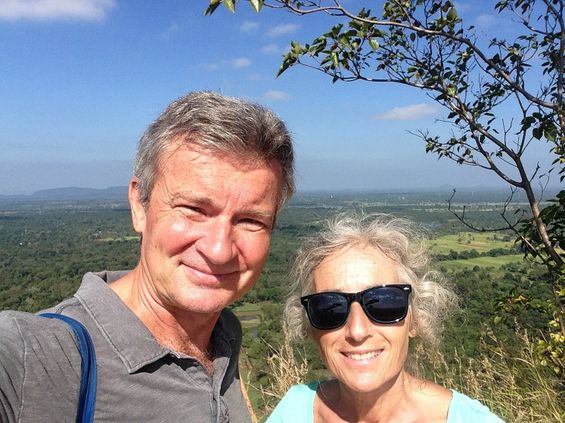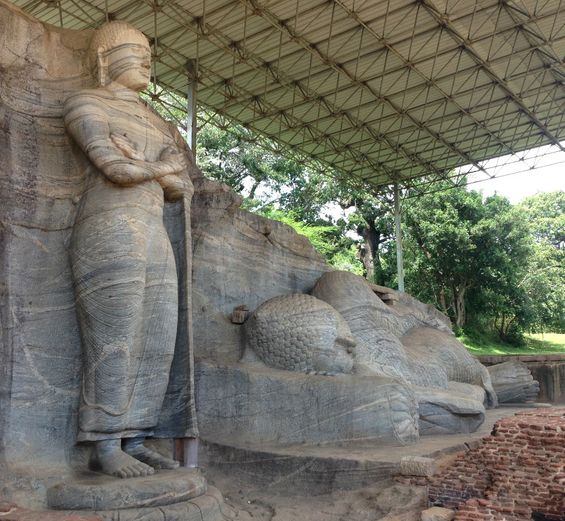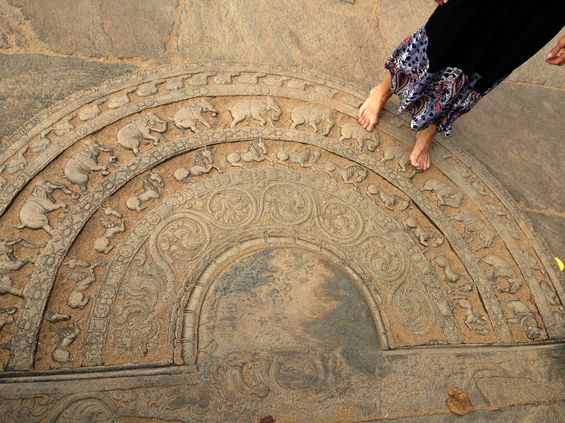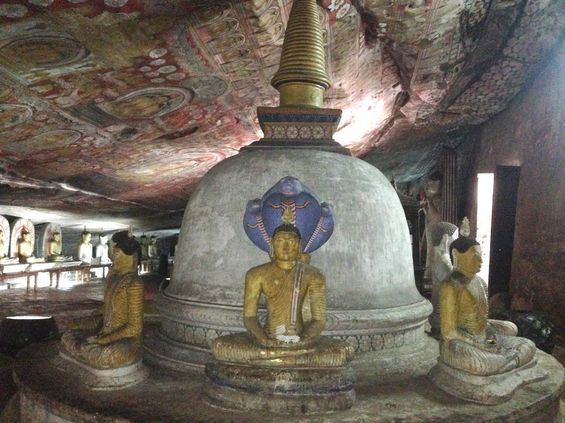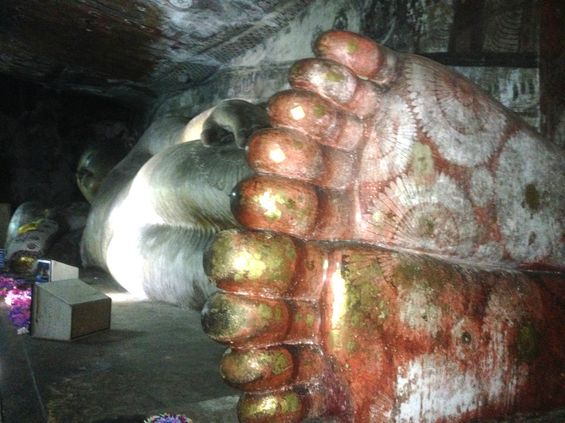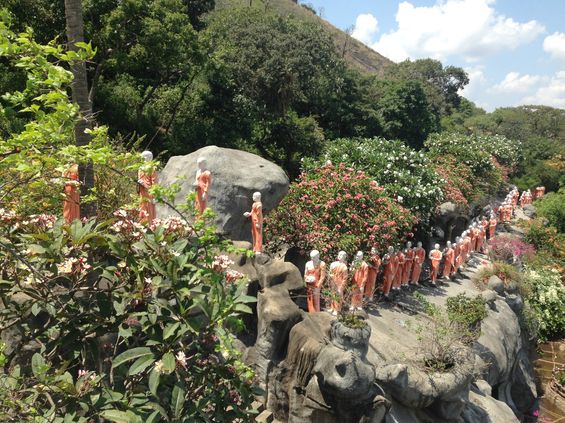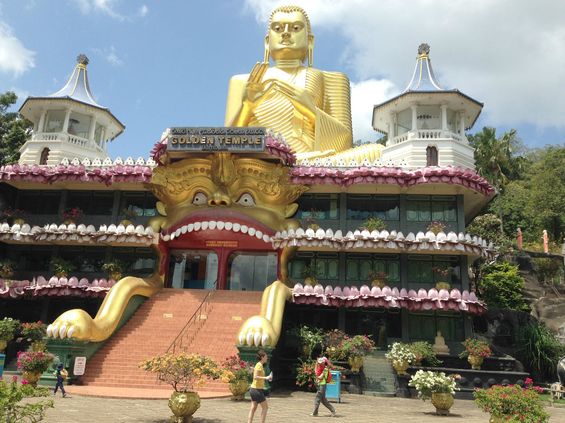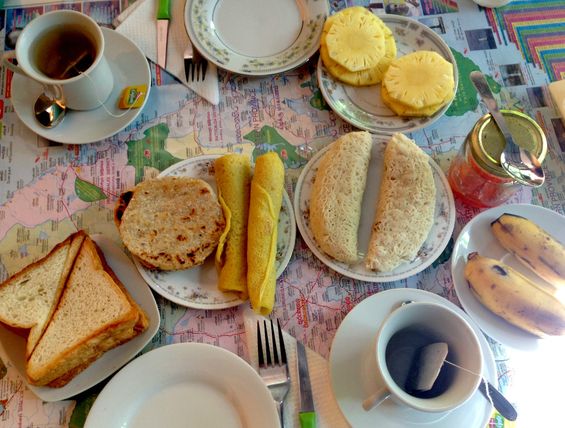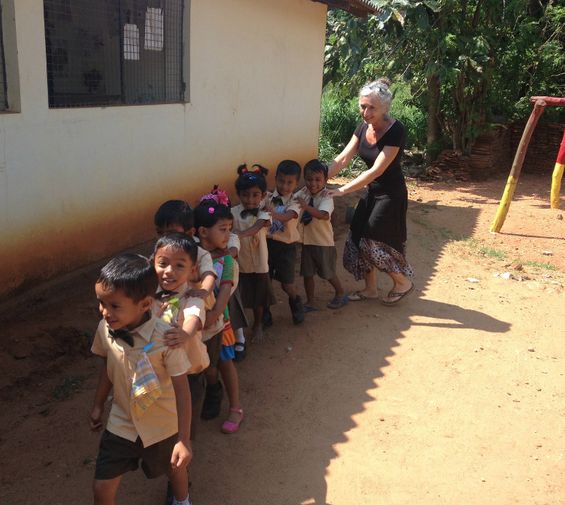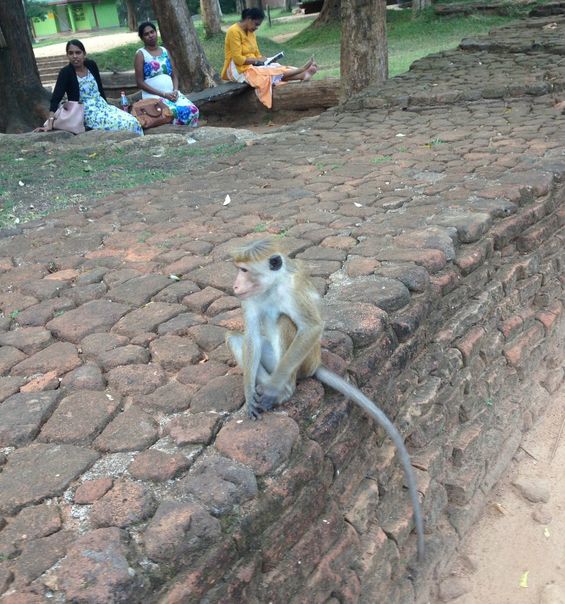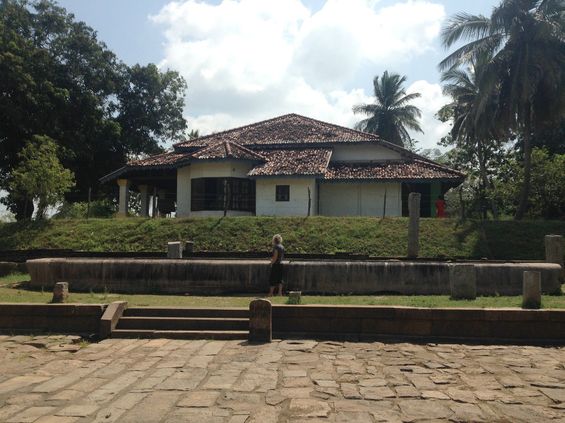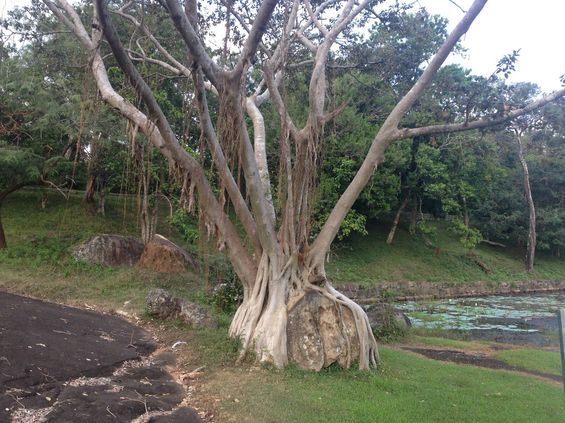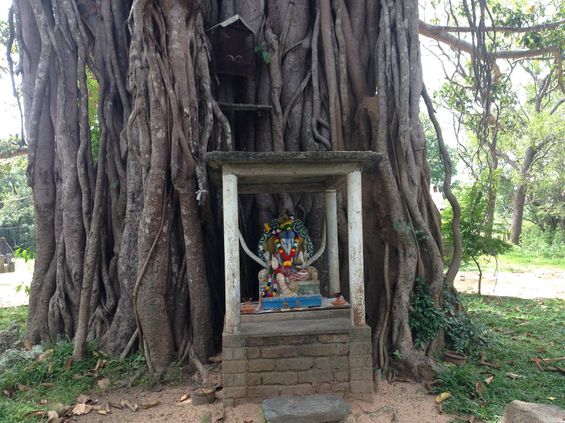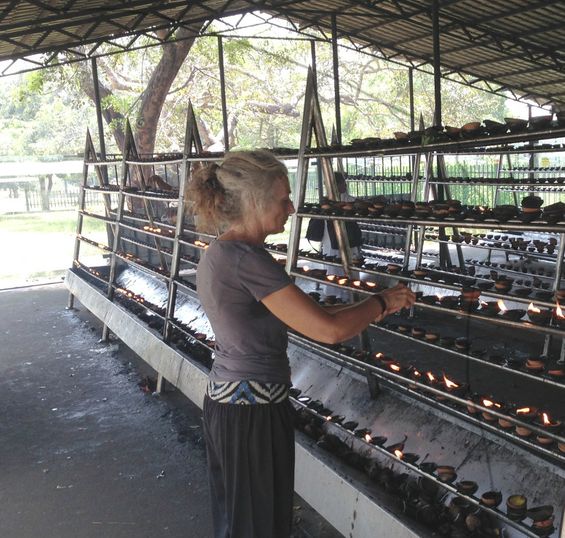SriLanka:Feb/Mar2016
We moved on to Sigiriya in the cultural heartland of the country, filled with 'crumbling temples, lost cities and ancient sites.'
Sigiriya stretches over an huge area with a gigantic rock in the middle. At the bottom of the rock are all sorts of caves formerly used by monks, and at the top are the remains of a palace (King Kassapa - a son who killed his royal father) or a giant temple complex. It's likely both, at different periods of history.
Half-way up the big rock there is a large, long overhang which was decorated with dozens of paintings of scantily-clad women. Guesses are they represent apsaras (celestial nymphs), King Kassapa's concubines, or Tara the female Buddha. The overhang has kept the paintings in amazing shape for centuries, out of the rain and sun. Photographs aren't allowed, so this is a photo of a reproduction in the museum.
This is the top of Sigiriya - lots of ruins, water tanks, and tourists!
Wild elephants still roam around here. Farmers have moved in and there is a constant battle now to keep the elephants out of the crops that have taken over their roaming lands.
More small caves near the top of Sigiriya. Note the giant white Buddha statue on the flatlands in the background.
We could see this giant Buddha from the top of Sigiriya, and found it after we got lost trying to find our way back to our guest house.
Another day, another mountain. This one is called Pidurangala and is about 2 kilometres from Sigiriya, seen in the background. The thin white band on the side of Sigiriya is a line of pilgrims climbing up the stairs.
Pidurangala also has a long rock shelf on its side about half-way up, which is divided into rooms. In one large room is a statue of Buddha after he entered parinirvana (Buddhas don't die). The statue was made of brick and covered with layers of a limestone cement to provide the final white surface. The sign beside the Buddha says, "Do Not Touch. Do Not Sit. Do Not Turn Back." We thought the "Do Not Turn Back" part was very inspirational since it was a pretty hard climb, but it actually means "Don't take selfies in front of the statue because it's disrespectful to turn your back on the Buddha...!"
"Do Not Turn Back".
We spent an afternoon in Polonnaruwa - an archeological park with hundreds of ancient structures. These statues (and two more) were all carved out of a huge shelf of rock. The reclining Buddha (14 m long) is actually a dead Buddha - you can tell by checking to see if the big toes of his feet are lined up or offset. If the top foot is pulled back a little bit, this is after the Buddha died. The standing statue (7 m) has sometimes been seen as Ananda, "grieving for his master's departure for nirvana". Ananda was the Buddha's attendant through most of his teaching life, who also happened to have a photographic memory. That's why there is such a wealth of the Buddha's teachings still around.
At the base of stairs to a temple there is often an elaborately carved semi-circular stone called a moonstone.
Incense for Annie.
You can always tell when the bread man is coming - depending on the village, they play a demented electronic version of either "Fur Elise" or "It's a Small World After-all". The other tune goes to the ice-cream man...
In central Sri Lanka there are many examples of small mountains rising out of the flat plains and near the tops of the mountains are long caves with overhanging rock. It looks almost like this area was once covered with water with the tips of the mountains as islands, and the water wore away these caves but usually from just one side, like in a big river with the caves formed on the upstream side. This cave is in Dambulla, one of at least 5 world heritage sites in the area.
These caves have been in use for at least six thousand years. For the last two thousand years many have become Buddhist temples or monasteries and over time, every available surface becomes covered with elaborate decorations.
Monk statues on parade! Sri Lanka has kept the Buddhist teachings alive over thousands of years as they have faded and reappeared over all of Asia and now the western world. In recognition, other countries often build temples in Sri Lanka. These statues are on the grounds of the Golden Temple in Dambulla, built by the Japanese in about 2000.
Golden Temple in Dambulla. Note the parading monk statues on the rocks on the right. The new and the old temples have a dramatically different feeling...
Breakfast. We usually get up around 7:00 or 7:30 and have breakfast at 9:00. There is always fresh fruit - right now, pineapples and bananas are in season. In this guest house, there are always white toast, little round rotis, pancakes rolled around a mixture of coconut and 'honey' (a kind of palm syrup), and 'something else' - in this case, the semicircular string noodles stuffed with more coconut and honey, or eggs, or ...! There is always very flavourful tea as well as the only type of coffee which now grows in Sri Lanka, which tastes a bit like mud. Sri Lanka used to have huge coffee plantations (British), but focussing on monoculture created conditions for a devastating blight, and the fungus is still in the soil. This occurred just at the time that the tea industry was taking off (introduced by James Taylor (not the singer) in the 1860's and massively commercialized by Thomas Lipton...).
Monkeys.
Roxanne found some pre-schoolers to play with.
More monkeys! The little guys are fun to watch...
but the bigger guys are trouble - mostly because of aggressive thefts of anything edible. It's best to keep any food out of sight, and a firm grip on your bags or backpacks.
A lady from Edmonton we met at the Millennium Elephant Foundation sent us this photo. Nice reminder of a nice time.
We moved on to Anuradhapura, and its massive Heritage Site full of ruins and 'archeological and architectural wonders'. This was taken near the Sri Maha Bodhi, the sacred bodhi tree grown from a cutting taken from the original Bodhi Tree in India (the tree under which the Buddha became enlightened). The long stone trough is about 45 feet long and was filled regularly with rice for the 3000 monks that used to live here in the 3rd century BC.
Trees1: Everywhere we go there are astonishing giant trees.
Trees2: The Sri Lankans have an eye for preserving beautiful and interesting ones.
Trees3: Shrines are often built into trees.
Candle for Annie outside Sri Maha Bodhi.
Please go to the next section: SriLanka: Mar 2016
